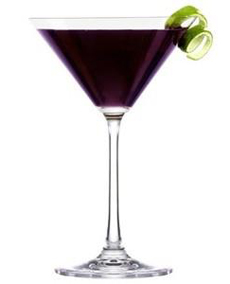RECIPE: Currant Cocktail
 Currantlicious: currant juice, vodka and triple sec. Photo courtesy CurrantC. |
We are huge fans of CurrantC black currant juice.
It looks like grape juice, but don’t let that fool you: It’s a bit grape-like, but currant tastes distinctive, bold, pleasantly tart and sophisticated. It’s the kind of juice wine drinkers would choose if they were designated drivers. And the extraordinarily high antioxidant levels of currants make blueberries, chocolate and green tea dull news. Look for CurrantC currant juice, or buy the concentrate online. Then, replace your morning O.J. with an even better-for-you glass of currant juice, cook with it (Cumberland Sauce is a classic for game, duck and pork), make sorbet and other desserts. And start with this delicious cocktail, a great fit with holiday celebrations. The recipe is courtesy CurrantC. |
|
|
CURRANTLICIOUS COCKTAIL RECIPE Ingredients Per Drink 1. COMBINE ingredients in a cocktail shaker with ice; shake and strain into a chilled Martini glass. 2. GARNISH with line and serve. The juice is also delicious frozen into high-antioxidant popsicles.
MIX CURRANT JUICE FROM CONCENTRATE It’s cost-effective to buy the concentrate and mix your own juice: 8 ounces cold water to 1 teaspoon CurrantC black currant concentrate. If you’d like it sweeter, you can add sweetener to taste—and keep the calories lower with a non-caloric sweetener. Look for recipes and buy currant concentrate and juice at CurrantC.com. |
||
|
CURRANT HISTORY: FORBIDDEN FRUIT Black currants are extremely popular in Europe and, prior to 1911, were big in the U.S. In 1911, the commercial cultivation of currants in the U.S. was outlawed by an act of Congress—for its alleged part in spreading the disease, white pine blister rust, which threatened the U.S. timber industry. The ban was based on incomplete scientific knowledge of the disease. At the behest of New York State farmers in this century, scientists from Cornell University revisited the white pine disease issue and concluded that currants didn’t pose the threat to white pines that was once believed. Until April 2003, black currants were “forbidden fruit” in the U.S. Then, following the Cornell studies, New York State* overturned the black currant farming ban, opening the door for New York currants—for eating, juice, jam, yogurt, tea and other applications. It’s also a boon for family farms, which now have an in-demand, non-commodity crop to revive sagging revenue. |
|
|
|
CURRANTS VS. RAISINS Since domestic currants only began to appear in the marketplace recently, what are those things we’ve been calling currants? They are the so-called Zante Currants, which are actually raisins (dried grapes) that have nothing to do with real currants.
After the commercial cultivation of currants was outlawed in 1911, currants dropped off the culinary radar screen. In the 1920s, Greece began to export small dried seedless grapes, one-fourth the size of the average raisin, from the area of Corinth, known in the U.S. as Zante currants Zante currants are not currants: They are the dried form of an ancient Greek grape variety properly called the Black Corinth, Vitis vinifera, the smallest of the seedless grapes. They come from the third largest Ionian Island called Zakýnthos, which is often called Zante (and where they were first cultivated more than 2,000 years ago). On the first shipment, the Greek writing for the word “Corinth” was mistakenly translated at the pier into “currant.” |
||



